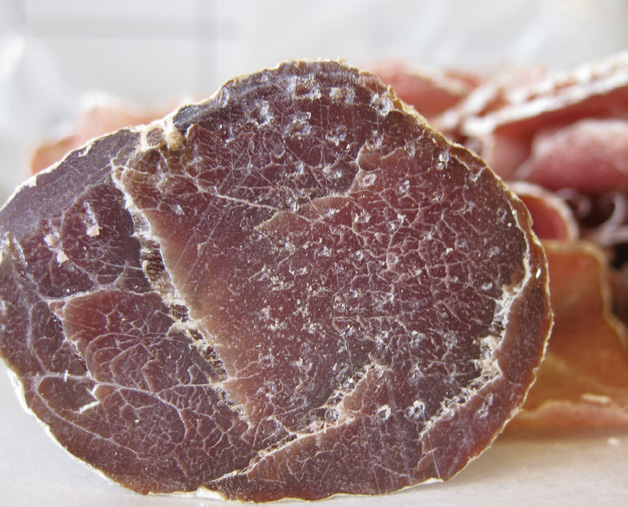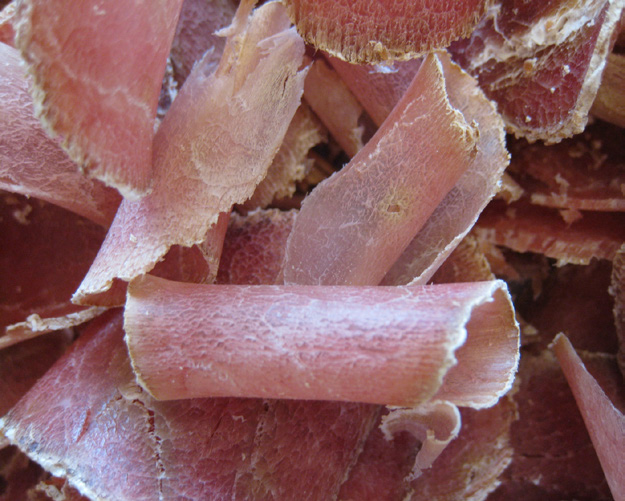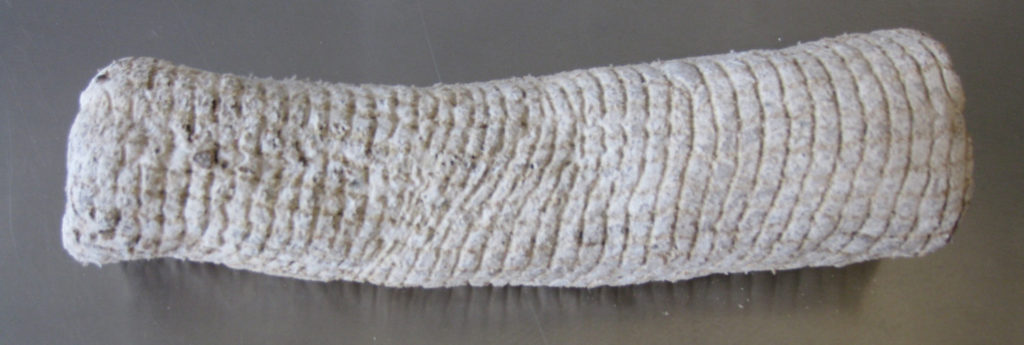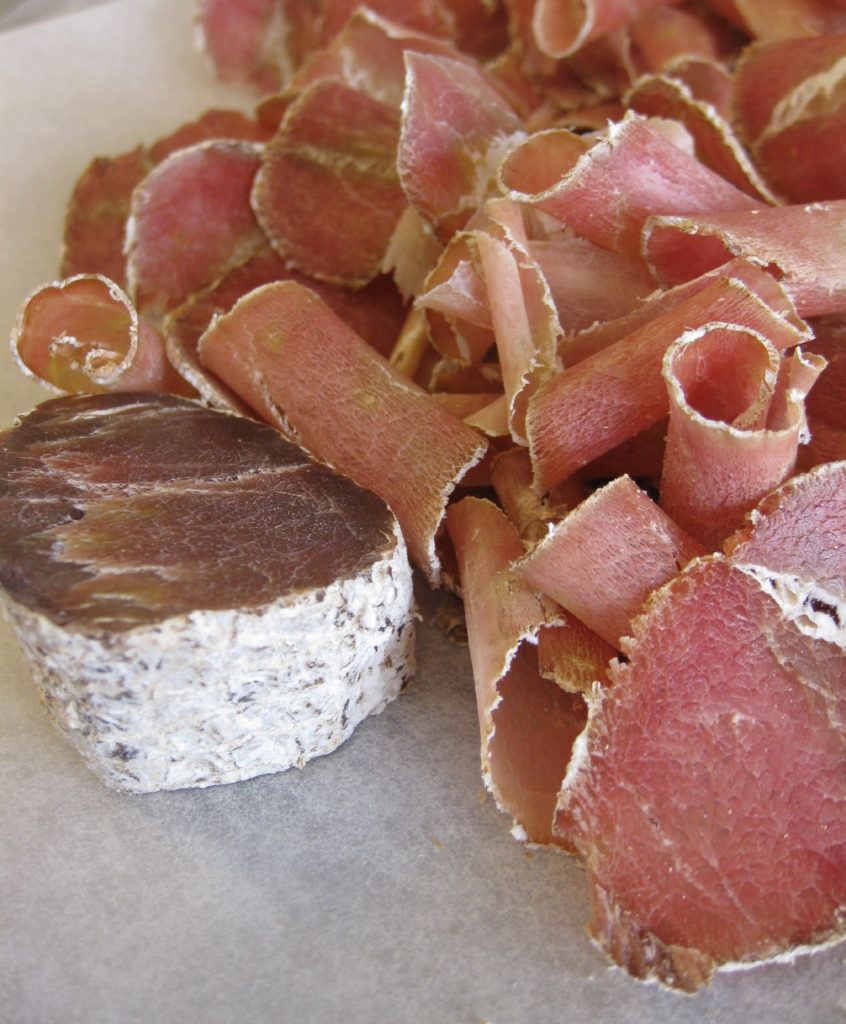posted by Anne Overmark
continued from Bushifying away the boar taint
excerpted from Anne’s MSc thesis entitled ‘Pork bushi – a gastronomic approach to tasty usage of boar-tainted pork’
After 50 days the pork filets were removed from the climate chamber. During the stay in the climate chamber the filets had lost a lot of weight and they ended up with an approximate average final moisture content of 19%, which is very similar to what is found in katsuobushi (18-20%). Fresh lean muscle (m. Longissimus dorsi) contains around 74% moisture and due to the dry nature of the pork bushi, the character of the meat had completely changed. When struck it now sounded like a resonant piece of wood and it took a lot of effort to slice it. The smell was pleasant with notes of smoke and dried meat, almost comparable to a Parma ham.
As the filets were going to be served not only to myself but also to a sensory panel and consumers, they were analyzed for potential pathogens. Both the Listeria monocytogenes and Stapphylococcus aureus tests showed negative results and when the water activity (aw) was measured in four out of nine filets, the average aw turned out to be 0.895. This aw is similar to what is found in dry-cured ham, and it will inhibit the growth of most pathogenic microorganisms (Andrés et al., 2007). Since there were no sign of pathogens present, which potentially could have contaminated the meat during the processing, and as the water activity was so low, the pork bushis were considered safe for consumption.
As mentioned the pork bushi is extremely hard and therefore inedible in larger pieces. Traditionally katsuobushi is used as a central ingredient in the katsuobushi-dashi, which can serve as a base for miso soup. Another way of eating it is as filling in onigiri, however in either way it is used in very thinly shaved flakes. I had access to a slicer used for bacon and other meats, and used the thinnest setting of 1.5mm for slicing the bushi. It would have been optimal, however, to use a plane like the one used in Japan, as it would have provided finer and more delicate flakes.
Inspired by work previously conducted at Nordic Food Lab (Mouritsen & Styrbæk, 2011; Mouritsen et al. 2012) and the traditional way of eating katsuobushi, it was decided to present the pork bushi to the sensory panel and consumers in a pork bushi/potato dashi.
Pork bushi potato dashi
½ kg old potatoes
40g leek
1L tap water
70g pork bushi flakes
The potatoes were peeled and the leeks were cut into smaller pieces. The potatoes were boiled at as low heat as possible until soft and the leeks were added halfway through. When the potatoes had finished, the dashi was sieved through a tea towel, and the pork bushi was added once the temperature had reached about 75⁰C. More bushi could be added, which would potentially increase the odour, flavour and taste; however 70g was chosen due to the limited amount available.
Three different dashis were prepared:
1: “control” – non-boar-tainted meat;
2: “low” – boar-tainted meat with skatole concentrations in the range (0.34-0.37ppm); and
3: ”high” – boar-tainted meat with skatole concentrations in the range (0.50-0.58ppm).




The sensory panel consisted of nine trained and professional judges, who are used to assessing boar-tainted meat and who are sensitive to skatole and androstenone. The panel expressed difficulties in finding any differences between the soups, and during the generation of the profile used in the sensory analysis, only one judge out of nine used ‘boar odour’ and ‘boar flavour’ as words to characterize the dashis. The final sensory analysis showed that only the boar odour of dashi 3, which contained the pork bushi with the highest skatole concentration, was perceived slightly, but significantly (p<0.05) different from the two others. The boar odour in the third dashi was perceived as being more intense. When experience of the sensory analysis was discussed with the panel members they all expressed surprise when told they had evaluated boar-tainted meat, and they emphasized that it was not nearly as repulsive as meat they had evaluated on other occasions.
Sensory defects as detected by trained panelists can still be tolerable for naïve consumers (Lawless & Claassen, 1993) and when the three dashis were presented to consumers (63) in the canteen at Gefion (Sorø), there were no significant differences between the liking of the odour or the flavour. However in general they were not too crazy about dashis.
The results from the sensory analysis and the consumer test indicate that boar-tainted m. Longissimus dorsi, processed in a similar way as the traditional Japanese product katsuobushi, has the same eating quality as non-tainted m. Longissimus dorsi. This is great news and what I hoped to see when I started this experiment. However it is not possible from this experiment alone to determine whether it is the bushi process or the actual skatole and androstenone concentrations in the fresh lean meat that does the trick. This processing technique can generate volatiles with the potential to mask the compounds which cause boar taint, thereby lowering its perceived intensity. The volatile composition of the bushi was not analyzed, and the skatole concentration was not determined in the finished products, thus it cannot be seen if the processing facilitates a generation of potent masking volatiles or a decrease in the concentration. Analyses of the fresh pork used for the processing of the bushis showed that the skatole and androstenone concentrations were much lower than the concentrations in the neck fat. The concentrations in the lean meat were lower than the threshold values too, and it may just be the low start concentrations, which influence the perception of boar taint in the filets used.
Even though I am not yet certain of why the boar odour and flavour is similar in meat from boar-tainted boars compared to meat from non-tainted pigs, at the end of the day pork bushi from m. Longissimus dorsi seem to be edible and nevertheless delicious.
Bibliography
Andrés. A., Barat. J. M., Grau. R., & Fito. (2007). Principles of Drying and Smoking. Chap.5. in Handbook of Fermented Meat and Poultry. Edt. Toldra. Blackwell Publishing.
Lawless. H. T., & Claassen. M. R. (1993). Validity of descriptive and defect-oriented terminology systems for sensory analysis of fluid milk. Jornal of Food Science. Vol. 58(1). pp. 108-
Mouritsen, O.G., & Styrbæk, K. (2011) Umami – Gourmetaben & den femte smag. Nyt Nordisk Forlag Arnold Busck A/S.
Mouritsen. O. G.,Williams. L., Bjerregaard. R., & Duelund. L. (2012). Seaweeds for umami flavour in the New Nordic Cuisine. Flavour. Vol.1(4). pp. 1-12.

